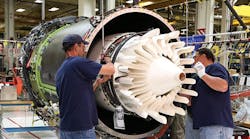GE Aviation Vows to 'Blueprint' CMC Material Production
GE Aviation (General Electric Corp. IW500/6) is promising to develop a ‘blueprint’ for industrialized production of ceramic matrix composite (CMC) components, the advanced-material parts it is relying on to reduce weight and improve performance characteristics for its jet engine and land-based gas turbine systems.
In a jet engine, such as the LEAP series or the forthcoming GE9X, CMCs in the engine can save millions of dollars annual in operating and maintenance costs. Thanks to an engines’ lighter CMC-based structure, a 1% reduction in fuel consumption can save over $1 million/year for commercial air carriers.
GE Aviation projects that its next generation CMC material technology will improve fuel efficiency by 1-2%.
CMCs are formed with silicon-carbide (SiC) ceramic fibers in a SiC matrix, and then coated with proprietary ceramic material. GE’s Global Research Centers and industrial businesses have been developing commercial applications for CMCs for over two decades. Last year, the group started construction of two adjacent plants in Huntsville, Ala.
When that $200-million project is completed, one plant will produce SiC ceramic fiber (the first operation in the U.S. to do this), while the second will use these SiC ceramic fibers to produce unidirectional CMC tape required to fabricate CMC components.
The Huntsville complex will produce up to 20 metric tons/year of CMC parts, and employ about 300 when fully operational.
American Machinist is an IndustryWeek companion site within Penton's Manufacturing & Supply Chain Group.




